
The national emblem of Belarus features a ribbon in the colors of the national flag, a silhouette of Belarus, wheat ears and a red star. It is sometimes referred to as the coat of arms of Belarus, although in heraldic terms this is inaccurate as the emblem does not respect the rules of conventional heraldry. The emblem is an allusion to one that was used by the Byelorussian SSR, designed by Ivan Dubasov in 1950, with the biggest change being a replacement of the Communist hammer and sickle with a silhouette of Belarus. The Belarusian name is Dziaržaŭny hierb Respubliki Biełaruś, and the name in Russian is Gosudarstvennyĭ gerb Respubliki Belarusʹ.

The Columns of Gediminas or Pillars of Gediminas are one of the earliest symbols of Lithuania and its historical coats of arms. They were used in the Grand Duchy of Lithuania, initially as a rulers' personal insignia, a state symbol, and later as a part of heraldic signs of leading aristocracy.

The Belarusian Popular Front "Revival" was a social and political movement in Belarus in the late 1980s and 1990s whose goals were national revival of Belarus, its democratization and independence from the Soviet Union. Its leader was Zianon Pazniak. It was similar to the Popular Fronts of Latvia and Estonia, and the Sąjūdis movement in Lithuania.

A four-question referendum was held in Belarus on 14 May 1995, alongside parliamentary elections. The four issues were the possibility of giving the Russian language equal status with Belarusian, whether new national symbols should be adopted, whether there should be economic integration with Russia and changes to the constitution that would allow early elections if Parliament systematically violated the constitution. According to official results, all four were approved by at least three-quarters of voters, with a turnout of 64.8%.
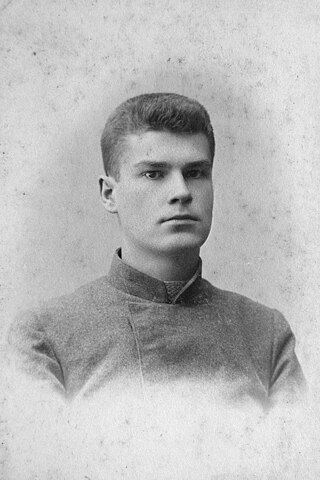
Maksim Adamavich Bahdanovich was a Belarusian poet, journalist, translator, literary critic and historian of literature. He is considered one of the founders of the modern Belarusian literature.
Upon the independence of Belarus from the Soviet Union, the country resurrected national symbols that were used before the Soviet era. These included a flag of red and white stripes and a coat of arms consisting of a charging knight on horseback. These national symbols were replaced by Soviet-era symbols in a disputed 1995 vote. Those two symbols, along with the national anthem, are the constitutionally defined national symbols of Belarus.

Uładzimir Katkoŭski was a Belarusian blogger, web designer and website creator.

Barys Tasman, was a Belarusian journalist, sports reporter and sports analyst.

Oleg Ivanovich "Alhierd" Bakharevich is a Belarusian writer and translator . In 1997 he graduated from the Philological Faculty of the Belarusian Pedagogical University in Minsk. Afterward, Bacharevič worked as a teacher of Belarusian and then as a journalist. His first texts were published in 1993. In the 1990s, he was one of the founders of the Belarusian literary and artistic avantgarde group Bum-Bam-Lit. In 1998, this group published the now cult anthology of their poetry, namely, Tazik biełaruski. At that time Bacharevič married Ksienija Brečka. They have one daughter, Uljana (Ульяна). Between 2007 and 2013, Bacharevič lived in Hamburg, Germany. In 2013, he returned to Minsk and married the Belarusian translator and poet, Julia Cimafiejeva. They lived in the Belarusian capital and cooperated in the field of Belarusian literature and culture, until the Belarusian White Revolution of Dignity in 2020–2021. Subsequently, in order to avoid arbitrary imprisonment and torture, the couple of authors chose emigration and left for Austria.

The Rada of the Belarusian Democratic Republic was the governing body of the Belarusian Democratic Republic. Since 1919, the Rada BNR has been in exile where it has preserved its existence among the Belarusian diaspora as an advocacy group promoting support to Belarusian independence and democracy in Belarus among Western policymakers. As of 2024, the Rada BNR is the oldest existing government in exile.
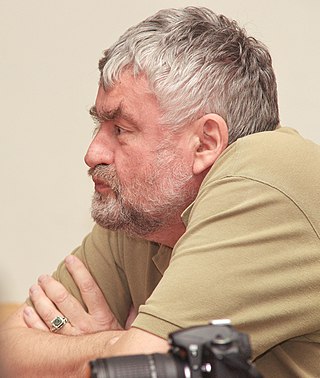
Uładzimir Arłou, known as U. A. Arlou is a Belarusian historian, writer, politician, and poet. He is chairman of the Belarusian PEN International.

Anton Ivanavič Luckievič was a leading figure of the Belarusian independence movement in the early 20th century, an initiator of the proclamation of the independence of Belarus, the Prime Minister and the Minister of Foreign Affairs of the Belarusian Democratic Republic persecuted by the Soviet authorities. He was a brother of Ivan Luckievič.
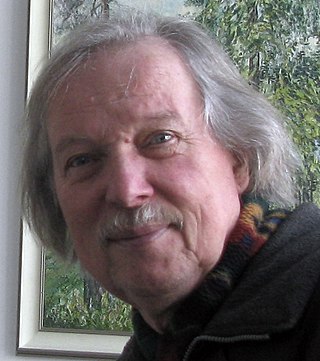
Aliaksandr Tsyrkunov, is a Belarusian artist, painter and sculptor.
Pahonia is a Belarusian patriotic song based on the eponymous poem by Maksim Bahdanovič.
"Mahutny Boža" is a famous Belarusian hymn, based on a poem by Natallia Arsiennieva and music by Mikola Ravienski. It was translated into English by Vera Rich.
Anatol Tsitou was a Belarusian historian and heraldist, known for his research of Belarusian heraldry.
Michaś Naŭmovič was a prominent figure of the Belarusian diaspora in France, artist and physiotherapist.
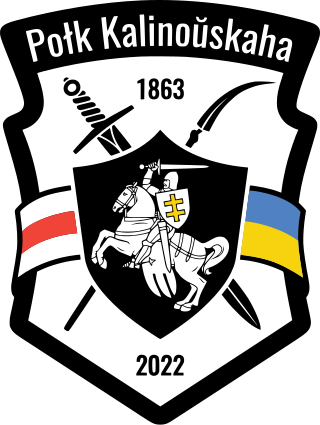
The Kastuś Kalinoŭski Regiment is a group of Belarusian opposition volunteers, which was formed to defend Ukraine against the 2022 Russian invasion.
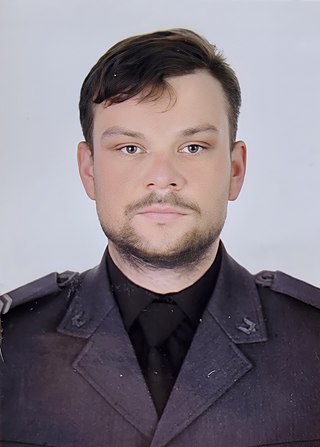
Aliaksiej Mikalajevič Skoblia, nom de guerre "Tur", was a Belarusian soldier who was deputy commander of the Kastuś Kalinoŭski Battalion under the Armed Forces of Ukraine. Skoblia died defending Kyiv from advancing Russian troops during the Battle of Kyiv in the 2022 Russian invasion of Ukraine. He was posthumously conferred the title of Hero of Ukraine by President of Ukraine Volodymyr Zelenskyy.

The Pahonia Regiment was a group of Belarusian opposition volunteers, which was formed to defend Ukraine against the 2022 Russian invasion.














